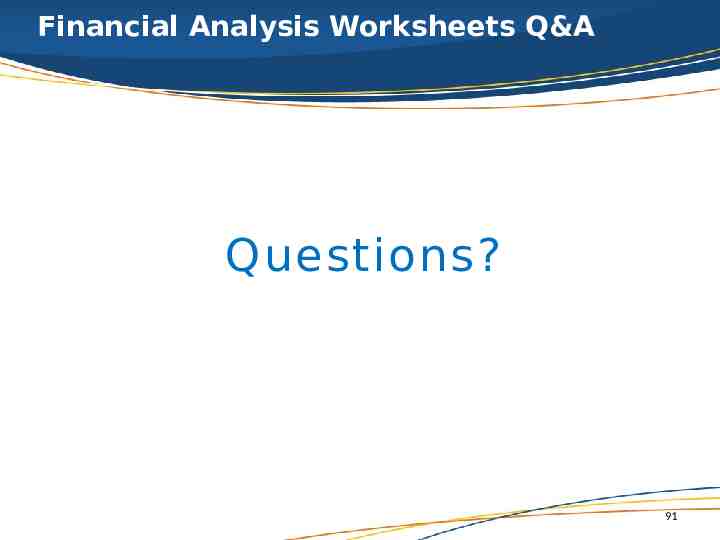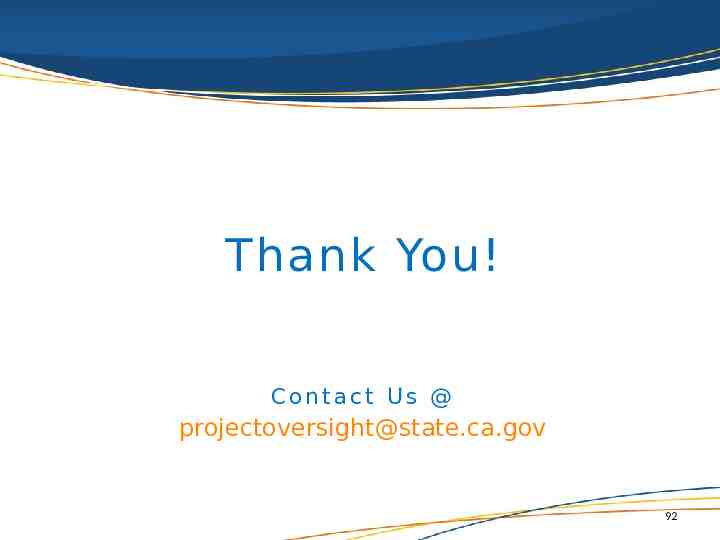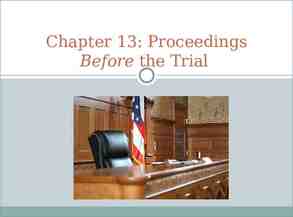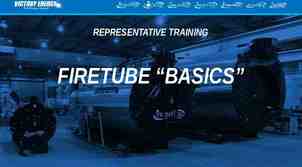Financial Analysis Worksheets (FAWs) Training
92 Slides3.84 MB
Financial Analysis Worksheets (FAWs) Training
FAWS TRAINING FAWS OVERVIEW SIMM BUDGET REQUEST TIMING & BUDGET LETTERS STEPS & WHO TO INVOLVE FAWS HANDS-ON & TRAINING EXERCISES REVIEW CRITERIA & TIPS SAMPLE LINKS & ATTACHMENTS 2
TODAY’S FAWS TRAINING FAWS OVERVIEW SIMM BUDGET REQUEST TIMING & BUDGET LETTERS STEPS & WHO TO INVOLVE FAWS HANDS-ON & TRAINING EXERCISES 3
JUNE 24 TRAINING FAWS HANDS-ON & TRAINING EXERCISES (Continued) REVIEW CRITERIA & TIPS SAMPLE LINKS & ATTACHMENTS 4
FAWS OVERVIEW FAWS OVERVIEW 5
Financial Analysis Worksheets (FAWs) Overview Intent: Document the financial analysis conducted and compare the current operations costs to the proposed alternative costs and financial benefits, including: Overall Staff Size (Current & New) Planning & Ongoing Costs Number of Fiscal Years (FYs) to Implement, i.e., Planning thru M&O (M&O Implemented for one complete FY) Financial Resources Source(s) Needed Alternatives Considered Outcome: A detailed record of the financial analysis used to identify the total estimated project cost, the financial impact on future operations costs, and the funding source(s), which ultimately contribute to: Good Investment Decisions Project Transparency Fiscal Accountability 6
Project Approval Lifecycle Create FAWs May Update FAWs Baseline FAWs 7
FAWS SIMM SIMM 8
SIMM 05A Reports and Activities Excerpt 9
SIMM 19 Project Approval Lifecycle SIMM Project Approval Lifecycle (PAL) guidelines and forms located in: – SIMM 19 Project Approval Lifecycle SIMM 19F Financial Analysis Worksheets http://www.cio.ca.gov/Government/IT Policy/SIMM 19/SIMM19.html 10
Cost Changes from Stage 2 to Stage Excerpt 4 from SIMM Section 19D Stage 4 Project Readiness and Approval, Section 4.13 Cost Baseline (Page 25): 11
FAWS BUDGET BUDGET REQUEST TIMING & BUDGET LETTERS 12
BCP Funding Needed? Timing of Resource Request Planning Funding for PAL Stages 2, 3, and 4 can be requested with an S1BA (approved prior to funding approval). Project Funding (Executing Process Phase activities) can be requested in a separate BCP with an approved Stage 2 (or Stage 3 or Stage 4, as applicable) prior to funding approval. 13
Funding Request Deadlines 14
PAL Planning Expenditures Planning Used? A DF-576 to DOF May Be Required. 15
PAL Planning Expenditure Reporting Planning Used Questions? Contact Your PAO Manager or DOF IT Consulting Unit 16
Project Increase Over 5M/20% Increase Cumulative Project Cost Increase 5M or 20% of total ? A DF-12 May Be Required. 17
Project Expenditure Increase 5M/20% Project Increase by 5M or 20% Questions? Contact Your PAO Manager or DOF IT Consulting Unit 18
Budget Confidentiality 19
Budget Confidentiality 20
FAWS STEPS & WHO STEPS & WHO TO INVOLVE 21
Steps to Complete the FAWs Step 1 Step 2 Step 3 Identify existing (current) costs for program operation and supporting information systems. Estimate onetime project costs for each alternative considered. Estimate future operations costs for each alternative considered. Step 4 Identify funding source(s) for selected alternative. Step 5 Update as additional information determined until baseline final FAWs. 22
Who to Involve 23
Who to Involve - Current Ops Cost FAWs Step 1: Identify existing (current) costs for program operation and supporting information systems. Program Business Sponsor Budget Office Entirely New Program The Program Business Sponsor should have a complete understanding of the current program and be able to assist in identifying the current program areas impacted. The Budget Office team serves as lead resource in the development of the FAWs during planning and has access to the current program costs Experts in the budget process, budget timelines, and cost estimation methods. If an entirely new program area (rare), no current costs exist. 24
Who to Involve – Alternative(s) Planning (Stage 2 – 4) FAWs Steps 2, 3, & 5: Estimate one-time & future operations project costs for each alternative considered. Update FAWs as needed based on known information. Note: Each department may involve other staff and/or program areas as needed. This is only a sample of the more common teams involved. Program Assist with solution requirements and program need, and obtains Business Sponsor buy in and support. Admin & Procurement Assist with market research, procurements, and staffing needs and planning. Project Management Manage the project team, assigns specific roles, deadlines, and develops overall project plan. Ensures SME involvement in project. IT Support The data custodian organization for the existing or proposed solution. Information Security Oversees and validates the security and privacy handling of information by the state entity and ensures suitable security control. Enterprise Architecture Articulates alternative concepts, explores and evaluates alternatives, and analyzes solution recommendations. Budget Office Leads the development of the Financial Analysis Worksheets. 25
Who to Involve – Alternative(s) FAWs Funding Note: Each department may involve other staff and/or program areas as needed. This is only a sample of the more common teams involved. Step 4: Identify funding source(s). Program Identifies known funding sources with Budget Office input, and obtains Business Sponsor buy in and support. May develop Budget Change Proposal (BCP) information aligned with funding. Project Management Manage the project team, assigns specific roles, deadlines, and develops overall project plan. Ensures project funding coordination and development of BCP content. Budget Office Leads the FAW funding needs and any BCP development, timing, and processes. 26
FAWS HANDS-ON FAWs Hand-On: Executive Summary & Summary Worksheets 27
Executive Cost Summary Worksheet Intent: Summarize the selected alternative’s planning costs (before project), project costs (during project), and future IT staff and operations costs (after project or continuing) into one sheet. Outcome: Provides a summary of the total project costs for the selected alternative. Summary cost information will be used to identify the total project costs and may be transferred to other cost tracking sheets (e.g., project status report) to be used as the project’s baseline. 28
Executive Summary Worksheet Step 1 Important Enter Project Name Department Name Project Number Date (This is helpful for versioning purposes) All other worksheets’ project information (project name, project number, etc.) populates from Step 1. Executive Summary data automatically populates as data is entered in the Alt -1 Project & Alt 1 -Future Ops. TOTAL PROJECT COST Total Project Costs information to be used in the Stage 4 Project Readiness and Approval (S4PRA) Letter. Note: This information must be consistent with the S4PRA Cost Baseline information. 29
Summary Worksheet Intent: Summarize the costs and financial benefits of each alternative into current operations costs (before project), project costs (during project) and future operations costs (after project). Outcome: Chronological presentation of key financial information for decision-making. Provides a basis to evaluate each alternative in terms of the cost to implement each alternative and the positive or negative impact on operations (positions and dollars) resulting from the implementation of the system. Important: The Summary Worksheet automatically populates as data is entered in Current Operations and each respective alternative worksheet (Alt # Project & Alt # Future Ops) 30
Summary Worksheet Average Current Operations Costs (Before Project) – Derived from information inputted into Current Annual Operations Worksheet (Current Ops); average of multi-year operations cycles Planning Costs (During Project) – Derived from information inputted into the Project Cost Alternative Worksheet; year-byyear cost to plan the project (one-time costs) Project Costs (During Project) – Derived from information inputted into the Project Cost Alternative Worksheet; year-byyear cost to implement the project (one-time costs) 31
Current Operations Costs Worksheet Intent: Identify and document the current annual cost to operate the program and supporting information system as they exist before an alternative solution has been implemented. Outcome: Provides information regarding the actual costs and relative size of the current business program and IT operations. Provides a baseline for the change in operations costs that may occur after the implementation of an alternative solution. 32
FAWS HANDS-ON FAWs Hands-On: Current Operations Worksheet 33
Current Operations Costs (Cont.) Personal Services – Classifications of existing staff that currently support business processes and IT systems impacted by the proposal. Program/IT – Differentiate business program staff from the IT staff supporting systems and infrastructure (if one exists). Monthly Salary – Current salary of each existing classification, not including benefits. Tenure/Time-Base – Identify positions as authorized/reflected in annual supplemental schedule of salaries and wages (Permanent, Temporary, Exempt, or Board). Optional Benefit Rate (%) – This optional field may be used when you have classifications with different benefit rates. 34
Current Operations Costs Excerpt from SIMM Section 19F.1 Financial Analysis Worksheets Preparation (Cont.) Instructions, Page 10: POSITION TYPE P Permanent T Temporary E Exempt Board Board Tenure/Time Base Information 35
Current Operations Costs (Cont.) Current Annual Operations Costs – Number of positions and associated costs for entire multi-year operations cycle. Show cost of current operations as if the project is not undertaken and operations continue in their current state. Note: If costs are consistent on a FY basis, only one year needs to be shown. Positions – Number of positions for each classification, identify partial positions (e.g., 0.1) as needed. Dollars – Automatically calculates annual salary based on monthly salary, benefits, and number of positions. If the optional benefits rate was used, the “Dollars” total with include the combined salary plus benefits. Average Current Operations Costs – Automatically calculates based on total average of all years. Identify the number of years of current annual operations costs to accurately calculate averages. Note: Up to ten years of current annual operations costs may be entered. 36
Current Operations Costs (Cont.) Operating Expenses and Equipment (OE&E) – Expenses that occur through normal business operations. Categories broken down by items of expense used in the BCP fiscal sheets. Additional items may be added but must comply with FI Cal definitions and cost codes. Staff related OE&E Note: “Local Assistance” – Expenditures of state funds provided to counties, cities, and special districts. This may not be applicable to most projects. The Local Assistance (rows 198 – 203) are currently hidden and may be unhidden as needed. 37
Quick Tips Current Operations Costs Worksheet Use Mid-Range Salary. Use the classification’s mid-range salary for positions needed during your project planning and future operations. This will help to align costs with any Budget Change Proposals (BCPs) needed. For more information, contact your Budget staff. New “Comments” Field. A new comment field was added at the bottom of each sheet for additional information related to your worksheets. Use the “New Comment” function in Excel to add a brief explanation. To do this, go to the Review menu tab and select New Comment. Include information helpful to explain contents. Hide Rows and/or Columns Not Used. For ease of viewing, hide rows and columns not used. This makes it easier to identify sections with information. 38
FAWS TRAINING EXERCISE FAWS Training Exercise 1: Current Operations 39
EXERCISE 1 Current Operations Costs Worksheet The Department of People Services proposes to improve access to records by digitizing paper records and closing down its records warehouse. The Records Unit currently has 10 full time and five (5) half time warehouse workers (mid-salary 3,699), as well as one (1) Staff Services Manager I (mid-salary 6,796) and two (2) Office Technicians (General) (mid-salary 3,455) (all permanent). The cost for benefits is 30%. Rent for the warehouse is 10,000 per month, utilities are 1,000 per month, and the cost to maintain the microfiche machine is 1,000 per month. The warehouse purchases 100 boxes of paper per year at the cost of 20 per box. Note: There are no fluctuating on-going costs from Fiscal Year (FY) 40 to FY.
Exercise 1 - Results Current Operations Costs Worksheet Results: 41
FAWS HANDS-ON FAWs Hands-On: Planning/Project Costs 42
Project Costs Worksheets Intent: Estimate the one-time project cost of implementing each alternative solution under consideration. Outcome: Provides one-time cost information to evaluate the relative merit of each proposed alternative. 43
Project Costs (Cont.) Project Costs – Year-by-year cost to Planning Costs - Year-by-year costs implement the project (one-time associated with planning activities costs). conducted in Stage 2 Alternatives Analysis through Stage 4 Project Readiness and Note: Up to ten project years Approval (one-time costs). may be included. Note: Up to five planning years may be included. Helpful Tip Enter the known or estimated Fiscal Year dates. 44
Project Costs (Cont.) Existing Staff to Be Redirected – Classifications of existing business program or IT staff resources to be redirected to the project. New Staff – Classifications of new business program or IT staff resources needed for the project. 45
Project Costs (Cont.) Annual Savings/Revenue Adjustments – Cost Savings, Cost Avoidances, Increased Program Revenues for each alternative solution under consideration. Simple Return on Investment (ROI) and Net Cost or Benefit are automatically calculated. Note: Entry required to show Cost Avoidances or Increased Program Revenues. 46
Essential Practices Project Costs Worksheet Use Mid-Range Salary. Use the classification’s mid-range salary for positions needed during your project planning and future operations. This should align with any Budget Change Proposals (BCPs) needed. For more information, contact your Budget staff. Label each alternative. Since each alternative Project Cost and Future Operations Costs worksheet is formatted similarly, make sure to appropriately label each alternative. Labels for Fiscal Years. Since each proposal may cover multiple budget years, use the dropdown to label the fiscal years (FYs) of Project Costs to be included (in FY YYYY/YY format). The FYs should align with any Budget Change Proposals (BCPs) needed. Change decimal to two places after decimal point (as needed). Cells calculate based on entry; however, for viewing purposes, it is helpful to change the “Positions“ cells to two places after the decimal (default only shows one place after decimal). 47
FAWS TRAINING EXERCISE FAWS Training Exercise 2: Planning & Project Costs 48
Exercise 2 Project Costs Worksheet The DPS’s recommended alternative is to scan the paper records in the warehouse and store the records in a new electronic content management repository. PLANNING: The project planning lasts nine (9) months (10/1/18 – 6/30/19) and includes one existing Staff Services Manager (SSM) I ( 6,320/mo.), one existing (1) IT Specialist I (mid-range 7,253), and a benefit rate of 30%. For planning, the DPS hires an outside vendor ( 75K for nine mos.) to assist with Stages 2 – 4 and also has CDT PAL Mgr. costs of 39,690 ( 147*30 hrs. monthly*9 mos.) PROJECT: The project to last two years, 10 months (7/1/19 – 4/30/22). The DPS needs one new IT Specialist (mid-range 7,253) and one new IT Associate (mid-range 5,492) for the project duration. The DPS will also redirect one SSM I (mid-range 6,320) and one Office Technician (mid-range 3,040) to work on the project. The benefit rate continues to be 30%. Remember to prorate the staff time in FY 2021/22; total Pos./12*mos. The new repository software is 150K one time (in first project year) and 5K annually after for support. The needed scanning software costs 25K one time (in first project year) and 1K annually after for support. The DPS needs to purchase five new scanners ( 1500 each) and all of the storage/servers will be hosted by a cloud services provider at a rate of 2K/per mo. beginning in the first project year. A vendor will be hired to scan all of the paper documents. The vendor charges 5 to scan 100 sheets of paper. There are one million sheets of paper (1,000,000/100 10,000 x 5 50K). A system integrator is needed to configure the repository, scanning software, and setup the database at an estimated cost of 100K. Prorate FY 2021/22 annual costs as appropriate. The PM services provided by the CA-PMO ( 125K/year; final year prorated for 10 mos. – ( 125,000/12*10 or 104,167 and a CDT Oversight Mgr. estimated costs of 119,952 ( 147*68*12) 49 per year; final year prorated for 10 mos. – ( 147*68*10 or 99,960).
Exercise 2 – Results (1 of 2) Project Costs Worksheet 50
EXERCISE 2 – RESULTS (2 of 2) Project Costs Worksheet 51
FAWS HANDS-ON FAWs Hands-On: Future Operations 52
Future Operations Worksheets Intent: Estimate and document the future costs for program operations and supporting information systems for each alternative solution. Outcome: Presents the total cost of ownership for the proposed alternative and identifies the difference between baseline operations costs and future operations costs. 53
Future Operations Costs (Cont.) IT Only Total (Future FYs) – Totals the IT IT Only Total (Future FYs) – Totals the IT positions, salaries and benefits for all full FYs salaries and benefits for all full FYs plus any plus any Overtime, Holiday, Other, and all Overtime, Holiday, Other, and all OE&E. OE&E. Average Future Operations Costs – Average of multi-year operations cycles after alternative has been implemented. Enter Final M&O FY – Once entered, automatically totals the IT salaries and benefits for the final FY plus any Overtime, Holiday, Other, and all OE&E. 54
Optional Benefit Rate (%) Use Important! If you use the Optional Benefit Rate, make sure you have not entered in both the “Optional Benefit Rate” and “Dept. Benefits Rate (% of Salaries/Wages)”: When both are entered, the lookup table multiplies the total salary ( 7253 * positions * 12 months * 30%) and then adds an additional 30% on the total IT salaries, which inflates the total Annual Fut. Ops. IT Costs (M&O Costs). In this example, the IT position earns 7253 per month or 87,036 for a full FY. By adding the Optional Benefits Rate AND the Dept. Benefits Rate, the IT positions total FY salary includes an55 inflated 30 %.
Optional Benefit Rate (%) Use Important! If you use the Optional Benefit Rate in the Future Ops worksheet, make sure you have not entered both an “Optional Benefit Rate” and a “Dept. Benefits Rate (% of Salaries/Wages)”: WITH ONLY ONE BENEFIT % INCLUDED: WITH BOTH THE OPTIONAL BENEFIT RATE & DEPT. BENEFITS RATE INCLUDED: 56
Optional IT OE&E Only Important! Only use the “Optional” blue section if the Operating Expenses and Equipment amounts lists are NOT to be included in your ongoing future operational costs. In most Columns cases, no entry will be needed in the “(Optional) Enter Total IT OE&E Costs Only” and “Optional) Enter IT OE&E for FINAL M&O IT Only”. In this example, the department had already included the Software Services (for repository/softwa re support) with program-related costs. If used, all totals must be reentered in the blue columns that are needed for the IT solution. 57
Optional IT OE&E Only Important! If you use the Optional IT OE&E Only columns AA & AC, you must MANUALLY Columns enter the OE&E totals for all future years (Column AA) and the final M&O year (Column AC) in the blue columns of the Future Ops worksheet. No entry is needed if all OE&E costs listed in the Future Ops sheet are to be included. TOTAL FUTURE COSTS WITHOUT THE OPTIONAL OE&E COLUMNS USED (NO ENTRY IN BLUE COLUMNS): TOTAL FUTURE COSTS WITH THE OPTIONAL OE&E COLUMNS USED: 58
Optional IT OE&E Only Important! Only use the “Optional” blue section if the Operating Expenses and Equipment amounts lists are NOT to be included in your ongoing future operational costs. In most Columns cases, no entry will be needed in the “(Optional) Enter Total IT OE&E Costs Only” and “Optional) Enter IT OE&E for FINAL M&O IT Only”. 59
FAWS TRAINING EXERCISE FAWS Training Exercise 3: Future Operations 60
Exercise 3 Future Costs Worksheet The project goes live on 5/1/2022. The partial FY costs (from 5/1 – 6/30/2022) during maintenance and operations (M&O) need to be captured. Therefore, prorate FY 2021/22 costs as appropriate. The final M&O FY year (FY 2022/23) (when M&O costs are stable with no fluctuations for a period of 12 months) provides the total annual future M&O costs. Costs: In order to operate and support the recommended alternative, the department will not need any of the Warehouse Workers. They will retain the one Staff Services Manager I (mid-range 6,320) and both of the Office Technicians (mid-range 3,040). The Department will need two new Office Technicians (mid-range 3,040) to scan future documents and one new Staff Information Systems Analyst (mid-range 6,130) to maintain the new system. Staff benefits continue at a rate of 30%. The warehouse will be closed, paper will no longer be purchased, and the microfiche machine will no longer be needed. Cloud services, repository, and scanning software support costs will continue in future annual operations. 61
Exercise 3 – Results (1 of 2) Future Annual Costs Worksheet 62
Exercise 3 – Results (2 of 2) Future Annual Costs Worksheet 63
FAWS HANDS-ON FAWs Hands-On: Funding Plan 64
Funding Plan Worksheet Intent: Identifies the funding sources, savings, and/or revenues that may be achieved through the implementation of the proposed alternative. Outcome: Provides a comprehensive funding plan for the proposed alternative including how all Project Costs will be funded through redirected resources, adjustments, and/or various funding sources. 65
Funding Plan (Cont.) Total Project Costs and Total Future Costs – Derived from information inputted into the Project Cost Alternative and Future Annual Ops. Worksheet Resources – Current operations resources to be redirected and utilized for project or future operations of the new system. Annual Funding Needed – Project (One-Time) (BCP) funding and Future Operations (Annual) (BCP) funding needed. Funding Source – Breakdown for how selected alternative will be funded, by percentage for each year. Funding Source, Local Assistance – Breakdown for how selected alternative’s local assistance will be funded, by percentage for each year. 66
FAWS TRAINING EXERCISE FAWS Training Exercise 4: Funding Plan 67
Exercise 4 Funding Plan Any cost savings from current operations will be redirected to help fund the new process. Half of any additional funding will be provided through the General Fund and the remaining funding will be provided though Special Funds. Be sure Row 24 “Total Additional Funding” matches funding requested in the BCP. Remember to add any Future FYs not already contained in the blue “Project Costs” section to the green “Future Annual” section. Add percentages to the “Funding Source, State Operations” section as needed. 68
Exercise 4 – Results Funding Plan 69
Exercise 4 – Results Funding Plan Where do the amounts come from? Excerpt Alt 1- Project, Row 356 Excerpt Alt 1- Future Ops, Row 363 Excerpt Alt 1- Project, Row 126 Existing Redirected Staff Excerpt Alt 1- Future Ops, Row 125 Existing Redirected Staff 70
FAWS HANDS-ON FAWs Hand-On: BCP Worksheet Tools 71
BCP Worksheet Tools Intent: Provide a tool to assist in the development of BCPs. Outcome: Additional documentation to validate and verify BCP information. 72
BCP Worksheet Tools Automatically pre-populates all totals based on the Alt 1 worksheets. Entry needed only if a department uses other existing funding sources to fund the project. Note: The totals on the BCP worksheets should align with Row 24 of the Funding Plan. 73
BCP Worksheet Tools Automatically pre-populates all totals based on the Alt 1 worksheets. Entry needed only if a department uses other existing funding sources to fund the project. Note: The totals on the BCP worksheets should align with Row 24 of the Funding Plan. Note: Columns hidden for viewing. 74
FAWS REVIEW CRITERIA & TIPS REVIEW CRITERIA & TIPS 75
Review Criteria The following questions will be asked of the Financial Analysis Worksheets: – Does the description information for the top 3 alternatives align with section 2.10 Alternative Solutions? – Does the existing cost worksheet align to section 2.5 Baseline Processes and Systems? – Does the Funding Plan percentage vertically total 100% by section/budget year? – Do the staffing and resources indicated cover the activities in all project phases outlined in section 2.11 Recommended Solution and 2.12 Staffing Plan? – Does the baseline costs in the Stage 4 Section 4.13 match may FAWs? Did I explain why there are any differences between my Stage 2 estimate to the final Stage 4 baseline costs? 76
FAWS Tip You may use formulas in the areas where you enter information. To determine partial year full-time Position equivalents (i.e., planning or project or maintenance and operations activities DO NOT begin on July 1 in a particular Fiscal Year), departments may use the following format in the “Positions” field: (Number of positions multiplied by the number of months divided by 12). The example below is the formula for two positions for nine (9) months (October – June 30): 2*(9/12)(Result will be 1.5) 77
FAWS Tip Ensure accurate average costs in the Current Operations and Future Operations sheets. Be sure the number of years with cost information equals the upper right hand column “Number of Years with entries.” The example below should be three years: 78
FAWS Review Criteria/Tip Future Ops Hide/unhide Rows/Columns as needed. Be sure to enter your FINAL Full M&O Year on the Future Operations sheet. 79
FAWs, Approval Letter, and S2AA Stage 2 Costs Approval Letter FAWs S2AA Stage 2 costs must match: Final Stage 2 FAWS Final S2AA Section 2.11.7 Cost Summary Stage 2 Approval Letter. 80
FAWS Review Area & Tip Funding Plan Funding Plan Rows 14 – 16 may be used to reduce the funds needed and reduce the amount shown in Row 24. Note: If this is used, an explanation is needed for the availability of existing funds, other funds, or OE&E. Example C 81
FAWs, Approval Letter, and S4PRA Stage 4 Costs Approval Letter FAWs Stage 4 costs must match: Final Stage 4 FAWS Final S4PRA Section 4.13 Cost Baseline Stage 4 Approval Letter. S2AA 82
FAWS Review Criteria/Tip Funding Plan If the Funding Plan sheet indicates “#N/A,” a invalid Fiscal Year was entered and must be changed. (See Example A) Make sure that at least one Fiscal Year is entered in the Funding Plan Future Annual column. (See Example A & B) Do not repeat a Fiscal Year that is already showing in Project Costs. The FAWs were designed to combine Project and Future Operations costs that overlap into a single Fiscal Year. (See Example B.) Example A Example B 83
FAWS SAMPLE Sample 84
Single Systems Integrator Solution Open files, “9999-015 CDTR SPSIVS.xls” and “9999-015 CDTR SPSIVS.doc” 85
Single Systems Integrator Solution Open files, “9999-015 CDTR SPSIVS.xls” and “9999-015 CDTR SPSIVS.doc” 86
LINKS & ATTACHMENTS Links & Attachments 87
LINKS AND ATTACHMENTS PROJECT APPROVAL LIFECYCLE RELATED Statewide Information Management Manual (SIMM) ( https://cdt.ca.gov/policy/simm/) – SIMM 05 Reporting Schedules ( https://cdt.ca.gov/wp-content/uploads/2018/06/SIMM-05A.pdf) – SIMM 19 Project Approval Lifecycle (https://cdt.ca.gov/policy/simm-19/) – F.1 Preparation Instructions ( https://cdt.ca.gov/wp-content/uploads/2019/07/F.1-Preparation-Instruc tions.pdf ) – F.2 Financial Analysis Worksheets Template ( https://cdt.ca.gov/wp-content/uploads/2019/09/F.2-Financial-Analysis-W orksheets-Template-1.xlsx#a11y ) 88
LINKS AND ATTACHMENTS BUDGET RELATED Budget Resources For Departments (ca.gov) – https://www.dof.ca.gov/budget/resources for departments/ Budget Letters (ca.gov) – https://www.dof.ca.gov/budget/Budget Letters/ – BL19-06 2020-21 Budget Preparation Guidelines (https://www.dof.ca.gov/budget/Budget Letters/documents/BL19-06.pdf) – BL20-27 IT Project Planning BCP Reporting Requirement https://www.dof.ca.gov/budget/Budget Letters/documents/BL20-27 Control Section 11-00.pdf BL20-27 Attachment DF12 (https://www.dof.ca.gov/budget/Budget Letters/documents/BL20-27 Attachment.docx) – BL20-28 IT Project Planning BCP Reporting Requirement (https://www.dof.ca.gov/budget/Budget Letters/documents/BL20-28 Information Technology Project Planning.pdf) BL20-28 Attachment DF576 (https://www.dof.ca.gov/budget/Budget Letters/documents/BL20-28 Attachment.xlsx) – BL20-30 2021-22 Budget Policy (https://www.dof.ca.gov/budget/Budget Letters/documents/BL20-30.pdf) – BL20-38 Governor’s Budget Supplementary Schedules (https://www.dof.ca.gov/budget/Budget Letters/documents/BL20-38.pdf) 89
LINKS AND ATTACHMENTS Attachments – 9999-015 CDTR SPSIVS Project FAW 9999-015 CDTR SPSIVS S4PRA Approval Letter F.1 Preparation-Instructions.pdf F.2-Financial Analysis Worksheets-Template BL19-06, BL20-027, BL20-27 Attachment, BL2028, BL20-28 Attachment, BL20-30, BL20-38 90
Financial Analysis Worksheets Q&A Questions? 91
Thank You! Contact Us @ [email protected] 92

































































































